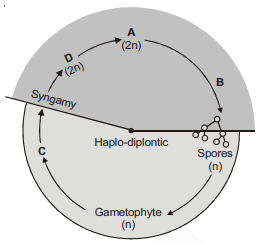Which of the following systems of classification involves usage of one or few morphological characters for grouping of organisms?
1. Artificial system
2. Natural system
3. Phylogenetic system
4. Bentham & Hooker’s system
Classification of organisms on the basis of fossils record that play important role in elucidation of evolutionary relationships is
1. Earliest systems
2. Phylogenetic systems
3. Morphotaxonomy
4. Artificial system
Plants which are not differentiated into roots, stems and leaves are
1. Algae
2. Gymnosperms
3. Pteridophytes
4. Angiosperms
Kelps are massive
| 1. | Brown algae |
| 2. | Amphibious plants |
| 3. | Flowering plants |
| 4. | Plants with naked seeds |
In Gracilaria, sexual reproduction is
1. Isogamous
2. Anisogamous
3. Oogamous
4. Both (1) & (2)
Ectocarpus is
| 1. | Unicellular green algae |
| 2. | Filamentous brown algae |
| 3. | Branched red algae |
| 4. | Colonial green algae |
Which of the following statement is incorrect regarding bryophytes?
1. They are dependent on water for sexual reproduction
2. The main plant body is diploid
3. They usually occur in damp, humid and shaded localities
4. They play an important role in plant succession on bare rocks
In mosses the sex organs are present in the
1. Protonema stage
2. Sporophytic stage
3. Leafy stage
4. Both (1) & (2)
Antherozoids represent
| 1. | Male gametophyte |
| 2. | Photosynthetic sporophyte |
| 3. | Female gametophyte |
| 4. | Motile male gametes |
In pteridophytes, spores germinate to give rise to
1. Prothallus
2. Protonema
3. Leafy stage
4. Strobili
In Selaginella the embryo develops into
1. Gametophyte
2. Sporophyte
3. Archegonium
4. Antheridium
The development of young embryos of pteridophytes within the female gametophytes is a precursor to the
1. Aquatic habit
2. Autotrophic habit
3. Seed habit
4. Parasitic habit
Which of the following possess vascular tissues but lacks seeds?
1. Mosses
2. Volvox
3. Ferns
4. Liverworts
Which of the following has both the male and female cones on same plant body?
1. Cycas
2. Ginkgo
3. Eucalyptus
4. Pinus
The megaspore mother cell is differentiated from one of the cells of the
1. Nucellus
2. Pollen grain
3. Microsporangia
4. Both (2) & (3)
Fusion of a male gamete with the secondary nucleus forms the
1. Zygote
2. Embryo
3. Seed
4. Endosperm
Eucalyptus is different from Cedrus in the presence of
1. Syngamy
2. Seeds
3. Archegonia
4. Triple fusion
Cotyledons are
| 1. | Modified roots |
| 2. | Embryonic leaves |
| 3. | Known as primary endosperm nucleus |
| 4. | Present in gymnospermic seeds only |
The diploid sporophyte is dominant in life cycle of
1. Volvox
2. Spirogyra
3. Chlamydomonas
4. Eucalyptus
The Bentham and Hooker’s classification is
| 1. | Classification of taxa based on actual examination |
| 2. | Artificial system of classification |
| 3. | Phylogenetic system of classification |
| 4. | Based on evolution |
Algin is a phycocolloid, obtained from the cell wall of
| 1. | Macrocystis and Porphyridium |
| 2. | Mastigocladus and Laminaria |
| 3. | Microcystis and Nereocystis |
| 4. | Macrocystis and Fucus |
Bryophytes are not characterised by
1. Sporophyte parasitic over gametophyte
2. Independent gametophyte
3. Absence of vascular tissues
4. Independent sporophyte
In Funaria, 20 chromosomes are present in rhizoids, then the number of chromosome in calyptra, theca and foot will be
| 1. | 20, 40, 40 respectively |
| 2. | 40, 20, 20 respectively |
| 3. | 20, 40, 20 respectively |
| 4. | 40, 10, 20 respectively |
Identify the plants A and B in the figures given below
1. A - Female Marchantia, B - Sphagnum
2. A - Riccia, B - Marchantia
3. A - Marchantia, B - Funaria
4. A - Male Marchantia, B - Sphagnum
In Pteridophytes, reduction division occurs when
| 1. | Prothallus is formed |
| 2. | Sex organs are formed |
| 3. | Spores are formed |
| 4. | Gametes are formed |
Which of the given sets are matched correctly?
a. Chondrus - Algin
b. Gracilaria - Agar
c. Cycas - Coralloid root
d. Pinus - Canada balsam
e. Adiantum - Walking fern
f. Lycopodium - Cord moss
g. Cedrus - Independent gametophyte
h. Sequoia - Tallest gymnosperm
1. b, c, e, h
2. a, b, c, e, f
3. b, c, e, g, h
4. b, c, d, e, g, h
Flowering plants are more successful than other members of the plant world because
1. They are large and have a good vascular tissue system
2. They carry out variety of pollination mechanism
3. The protected plant embryo can survive in the period of unfavourable conditions
4. All of these
Identify the labels A, B, C and D in the figure given below
1. A - Sporophyte; B - Meiosis
C - Gametogenesis; D - Endosperm
2. A - Sporophyte; B - Mitosis
C - Gametogenesis; D - Zygote
3. A - Gametophyte; B - Meiosis
C - Gametogenesis; D -Zygote
4. A - Sporophyte; B - Meiosis
C - Gametogenesis; D - Zygote
Monoecious plant of Chara shows occurrence of :
| 1. | Stamen and carpel on the same plant |
| 2. | Upper antheridium and lower oogonium on the same plant |
| 3. | Upper oogonium and lower antheridium on the same plant |
| 4. | Antheridiophore and archegoniophore on the same plant |
Gymnosperms are also called soft wood spermatophytes because they lack:
| 1. | Thick-walled tracheids |
| 2. | Xylem fibres |
| 3. | Cambium |
| 4. | Phloem fibres |